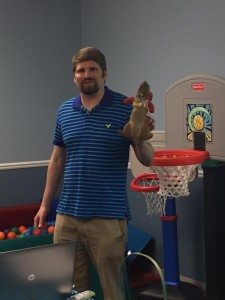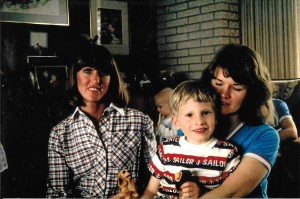5 Practical Tips for Teaching Students with Autism
August 30, 2017
By: Ron Sandison
Categories: Education
Next in our back to school series, self-advocate Ron Sandison shares his tips for educators teaching children on the autism spectrum.

My sister-in-law is a two time teacher of the year winner for her county with sixteen years of experience. Her first teaching assignment lasted just two weeks. She was hired as assistant teacher of a class of autism students. After ten days of being hit, bit, scratched, and spit on, one of the students in her class cried, “I want my mommy!” She said to her co-teacher, “I want my mommy also!” as she made her MacGyver-like escape.
Teaching students with autism and disabilities is hard work—it requires love and dedication combined with patience and perseverance. I commend every teacher who invests his or her time figuring out each student’s unique needs and the strategies to best educate them.

Yale professor James Comer said, “No significant learning can occur without a significant relationship.” When I was in elementary school Ms. Michelle would bring me plastic squirrels and animals toys. Ms. Michelle taking an interest in my love for animals caused me to behave in her classroom and be an attentive listener. As the ancient Chinese proverb says, “When the student is ready, the teacher will appear.” Ms. Michelle prepared my mind and heart to learn.
When grading papers have positive comments at the beginning and end to offset the negative comments. If a paper is poorly written instead of covering it in red ink, write, “Please come see me and we can discuss it in more detail.”
Teachers should consider using a different pen color than red, maybe blue or green, for corrections since students with autism associate red ink with failure and negativity. Often autistic students take everything personally and have difficulty handling constructive criticism which can lead to a meltdown. When a student is putting forth effort, reward him or her with stickers or a small tangible reward. You can purchase rewards from the dollar store.
Students with autism tend to fail at social graces and misinterpret communication clues. One fun social skill building game you can play in your class is “Would You Rather?” You play by simply answering the question ‘would you rather?’ For example, you could ask your students the question ‘would you rather be Batman or Superman?’ Then ask the question ‘why?’. Another good question could be, ‘would you rather be, Obi Wan Kenobi or Luke Skywalker, and why?’. This simple exercise teaches children how to take turns, communicate ideas, shift topics, and gives a structure to conversations.
Many children with autism and learning disabilities have more than just one disability which can hinder their education and social development. I had great difficulty in high school and elementary school learning phonetically due to auditory processing disorder (APD) and dyslexia.
My freshman year of high school, I received a D in Spanish class due to my inability to learn a foreign language by phonetic repetition. Three different times in this class the teacher gave me a detention for behavioral problems. My inability to learn Spanish caused me to misbehave by making inappropriate jokes and swearing.
In college at ORU, during my Master of Divinity program, I took Biblical Greek for three years and had a perfect 4.0 GPA since I learned the language not by phonetics but visually with vocabulary and grammatical flashcards which enabled me to use my great visual memory.
Sensory issues can hinder students with unique needs from learning. It is important to prevent sensory overload which can result in negative behavior, fear, anxiety, withdrawal, increased repetitive behavior, tantrums or a complete meltdown in the classroom. The majority of us pay little attention to our senses. When we feel cold, we put on a sweater. When music is too loud, we turn down the volume. For some children, senses provide unreliable information, causing great discomfort and anxiety. They may experience sensory issues with touch, sound, taste, smell, or sight. Ask your student if he or she has any sensory issues.
You should recognize your students with autism’s warning signals that a tantrum or meltdown could occur. Be alert and monitor these responses: pacing, hyperactivity, increased anxiety or agitation, hand-to-face repetitive motions, rocking back-and-forth, jumping side-to-side, intensified internal stimuli (talking to themselves), or excessive stimming (self-stimulatory behavior for soothing).
When teaching students with autism have a schedule for the class posted on the board—it helps the student to know what to expect during the day, reducing his or her anxiety and stress.
The best teachers for students with autism have tight boundaries with a softness of heart—a perfect combination of structure yet nurturing.
Stephanie Holmes whose daughter has Asperger’s said, “Boundaries with love and relationship are key for teachers working with autistic and special needs children.” Always remember the best way to connect with your students is through love and acceptance.
About the Author
Ron Sandison works full time in the medical field and is a professor of theology at Destiny School of Ministry. He is an advisory board member of Autism Society Faith Initiative of Autism Society of American and The Art of Autism. Sandison has a Master of Divinity from Oral Roberts University and is the author of A Parent’s Guide to Autism. Biblical Wisdom published by Charisma House. He has memorized over 10,000 Scriptures including 22 complete books of the New Testament and over 5,000 quotes.
Ron has published articles in Autism Speaks, Autism Society of America, Autism File Magazine, the Art of Autism, Autism Parenting Magazine, Not Alone, the Mighty, the Detroit News, the Oakland Press, and many more. He frequently guest speaks at colleges, conferences, autism centers, and churches. Ron and his wife, Kristen, reside in Rochester Hills, MI, with a baby daughter, Makayla Marie born on March 20, 2016. You can contact Ron at his website or email him at sandison456@hotmail.com.